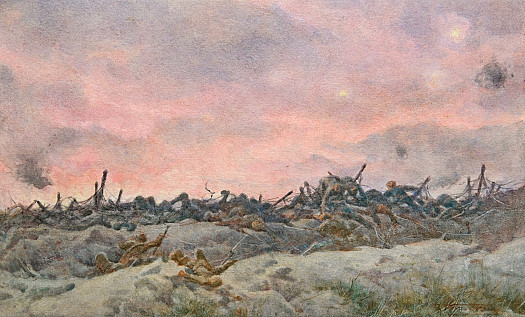Robert George Talbot Kelly was born in Birkenhead, Cheshire, on 18 January 1861, the fourth of the eleven children of the Dublin born artist, Robert George Kelly, and his Scottish wife, Mary (née Walker). Growing up at ‘Glasnevin’, 39 Balls Road, Claughton with Grange, Birkenhead, he was educated at Birkenhead School and studied art under his father.
However, he worked as a clerk in a firm of cotton traders until 1882, when he then decided to take up art as a profession and go abroad. Travelling in Spain and North Africa, he settled in Cairo in 1883, and there both acquired a studio and learned Arabic. Eventually, he would receive commissions from aristocrats and dignitaries who visited his studio as one of the sights of Egypt. From the mid 1880s, he exhibited in Liverpool, at the principal London galleries, and on the Continent, and though he initially appeared as ‘R G Kelly Jr’,
he soon inserted the family name of ‘Talbot’ to avoid confusion with his father.
Despite the fact that Kelly had made his name as an Orientalist, he was invited, in July 1890, by a businessman to visit and paint Iceland, in the company of eight other artists, photographers and researchers. During their fortnight’s stay, they travelled to Krýsuvík, Hekla, Geysir and Þingvellir. The paintings that resulted expanded his repertoire, and, in 1893, he was elected a member of the Royal Society of British Artists. By that date, he had settled in Birkenhead, and established a studio at 24 The Temple, Dale Street, Liverpool. Then, in 1894, he married Lilias Lindsay, the daughter of Ebenezer Lindsay of Hartside Farm, Lamington and Wandel, Lanarkshire, Scotland. They would have two children, including Richard Barrett Talbot Kelly, the painter of birds and historical subjects.
In 1897, Kelly began a career as a published author and illustrator. He illustrated Fire and Sword in the Sudan by Baron Rudolf Carl Slatin Pasha, and wrote ‘In the Desert with the Bedouin’, the first of a series of articles on his Egyptian experiences that appeared in The Century Magazine. At the turn of the century, he began to return to Egypt, and is recorded as sailing from Liverpool to Port Said in 1899 and 1901. Then, from 1902, when he moved to Swiss Cottage, London, until 1914, he maintained a studio in Cairo as well as one at 4 Primrose Hill Studios. In 1902, he wrote and illustrated Egypt: Painted and Described and in both 1902 and 1904 held exhibitions of his Egyptian subjects at the Fine Art Society. At some point, he was awarded the Order of the Medjidie from the Kedive of Egypt.
In 1903-4, Kelly spent a year in Burma at the request of the Burmese Government. In 1905, he wrote and illustrated Burma: Painted and Described and held an exhibition of his Burmese subjects at the Leicester Galleries. He held further exhibitions with the Leicester Galleries in 1908 and 1910, and in 1908 published both Burma and Egypt in A & C Black’s series, ‘Peeps at Many Lands’. He was elected to the Royal Institute of Painters in Water Colours, in 1908, and the Royal British Colonial Society of Artists, in 1910, and would serve on the committee of each. He was also elected to the Royal Geographical Society and the Royal Zoological Society.
Kelly was 53 years old when the First World War broke out in 1914, and it is not known whether he undertook any war service. However, his son, Richard served in the Royal Artillery in France between 1915 and 1918 (and remained in the army until 1929). Continuing to paint and exhibit, Kelly held a solo show at the Fine Art Society in 1916 and – maintaining contact with his native Northwest – became President of the Liver Sketching Club in 1917. His wife, Lilias, died in that year.
Following the end of the war, Kelly resumed his travels, but focussed on Europe, and held a solo show of watercolours of the Côte d’Azur at the Fine Art Society in 1924. By then, he and his son, Richard, were sharing 3 St John’s Wood Studios, Queen’s Terrace. He died a decade later, on 30 December 1934, at the Cancer Hospital, Fulham Road, Chelsea.
His work is represented in numerous public collections, including the Williamson Art Gallery (Birkenhead).


